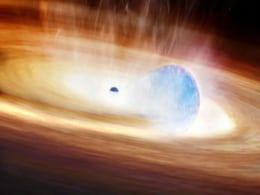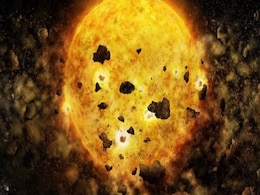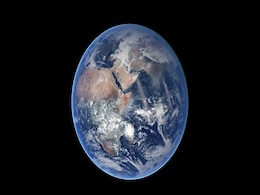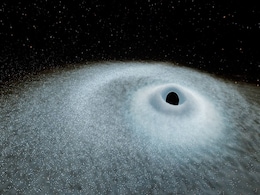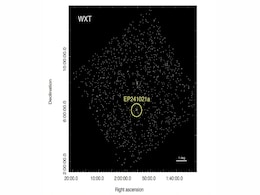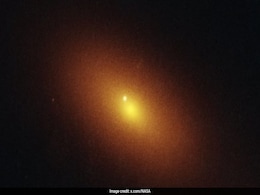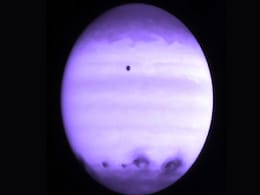Tidal
- All
- News
- Videos
-

Study Reveals Saturn's "Mimas" Moon Might Have Hidden Boiling Ocean Under Its Ice
- Friday November 28, 2025
- Science | Edited by Astitva Raj
But on larger icy moons, the ice layer may break up before the water boils, preventing the formation of a boiling ocean.
-
 www.ndtv.com
www.ndtv.com
-

NASA's Astronomers Reveal Red Giant Stars May Destroy Their Own Planets
- Monday November 10, 2025
- Science | Edited by Astitva Raj
This extreme expansion poses a serious threat to nearby planets. For example, when the Sun becomes a red giant in about 5 billion years, it will likely swallow Mercury and Venus.
-
 www.ndtv.com
www.ndtv.com
-

India's Big Warning To Pakistan Against Aggressive Approach Towards Sir Creek
- Thursday October 2, 2025
- World News | Press Trust of India
In a clear message to Pakistan, Defence Minister Rajnath Singh on Thursday warned the neighbouring country against any aggression towards the Sir Creek region and said that any such move would be met with a "resounding response".
-
 www.ndtv.com
www.ndtv.com
-

This River In China Flows Backwards - And The Sight Attracts Thousands Of People
- Saturday August 23, 2025
- Travel | Edited by Toshita Sahni
Tidal waves on the Qiantang River in Hangzhou may reach heights of thirty feet and surge ahead at the speed of forty kilometres per hour.
-
 www.ndtv.com/travel
www.ndtv.com/travel
-

Astronomers Observe Rare Supernova–Black Hole Interaction in Early Stages
- Sunday August 17, 2025
- Written by Gadgets 360 Staff
In a groundbreaking discovery, astronomers observed SN 2023zkd, a supernova that may have been triggered by close interaction with a black hole. Featuring unusual brightness peaks and extended pre-explosion activity, the event offers new insights into star black hole dynamics. Real-time AI detection played a key role, and upcoming surveys promise t...
-
 www.gadgets360.com
www.gadgets360.com
-

Doomed Exoplanet TOI-2109b Spirals Toward Its Star with Three Possible Fates
- Monday July 28, 2025
- Written by Gadgets 360 Staff
The gas giant TOI-2109b, over five times Jupiter’s mass, is spiraling closer to its star in a rare planetary death spiral. With a 16-hour orbit and blistering heat, the exoplanet could either plunge into its host star, be torn apart by tidal forces, or evolve into a rocky super-Earth through photoevaporation. NASA’s TESS and ESA’s Cheops data...
-
 www.gadgets360.com
www.gadgets360.com
-

Earth’s Spin to Speed Up Briefly, Causing Shorter Days This Summer
- Monday July 14, 2025
- Written by Gadgets 360 Staff
Scientists report that Earth will briefly spin faster on July 9, 22, and August 5, shortening those summer days by 1.3 to 1.5 milliseconds. Though undetectable in daily life, this shift offers clues to how lunar gravity and seasonal changes affect planetary dynamics. Experts note that while timekeeping systems like GPS are unaffected, this rare spe...
-
 www.gadgets360.com
www.gadgets360.com
-

Astronomers Discover Most Powerful Cosmic Explosions Since the Big Bang
- Saturday June 7, 2025
- Written by Gadgets 360 Staff
Astronomers have discovered extreme nuclear transients — rare and powerful explosions caused by stars being torn apart by supermassive black holes. These events, brighter and longer-lasting than supernovae, were observed using data from Gaia and ZTF. As the most energetic cosmic outbursts since the Big Bang, they offer valuable insights into blac...
-
 www.gadgets360.com
www.gadgets360.com
-

Einstein Probe Detects Mysterious X-ray Flare with Record-Long Emission
- Tuesday May 27, 2025
- Written by Gadgets 360 Staff
An international team of astronomers has detected a peculiar fast-evolving X-ray transient, EP241021a, using China’s Einstein Probe. Unveiled in a May 12 arXiv paper, this transient stood out due to its long-lasting emissions lasting over 79 days—unprecedented among FEXTs. EP241021a also produced optical and radio emissions, suggesting a multi-...
-
 www.gadgets360.com
www.gadgets360.com
-

Hubble Captures First-Ever Rogue Black Hole Devouring a Star Outside Galactic Core
- Thursday May 15, 2025
- Written by Gadgets 360 Staff
Astronomers led by Dr. Yuhan Yao have discovered the first offset tidal disruption event (TDE), where a rogue black hole outside a galaxy's core ripped apart a star. Spotted by the Hubble telescope and Zwicky Transient Facility, this marks historic evidence of a wandering supermassive black hole in action.
-
 www.gadgets360.com
www.gadgets360.com
-

Hungry Black Hole Rips Apart And Swallows 'Hapless' Star 600 Million Light-Years Away
- Friday May 9, 2025
- Science | Edited by Abhinav Singh
The tidal disruption event (TDE) took place 600 million light-years away and was caught by the Hubble Space Telescope.
-
 www.ndtv.com
www.ndtv.com
-

Black Hole That Swallowed Star 600 Million Light-Years Ago Found, NASA Shares Pic
- Friday May 9, 2025
- World News | Edited by NDTV News Desk
NASA has captured the astronomical event, called a Tidal Disruption Event (TDE), using its Hubble Space Telescope.
-
 www.ndtv.com
www.ndtv.com
-

Space Research Reveals How Icy Comets and Asteroids Could Reshape Earth-Like Planets
- Saturday May 3, 2025
- Written by Gadgets 360 Staff
New scientific models and telescope observations from 2024 and 2025 reveal how comet and asteroid impacts can change atmospheres on Earth-like exoplanets, potentially supporting life or triggering climate disruption.
-
 www.gadgets360.com
www.gadgets360.com
-

What Happens if You're Struck By A Tiny Black Hole? Study Reveals Shocking Details
- Tuesday February 18, 2025
- Science | Edited by Nikhil Pandey
A recent study explores the effects of tiny black holes on the human body, finding that while tidal forces would cause local damage, shock waves could be deadly, but the likelihood of being struck is incredibly low.
-
 www.ndtv.com
www.ndtv.com
-

Study Reveals Saturn's "Mimas" Moon Might Have Hidden Boiling Ocean Under Its Ice
- Friday November 28, 2025
- Science | Edited by Astitva Raj
But on larger icy moons, the ice layer may break up before the water boils, preventing the formation of a boiling ocean.
-
 www.ndtv.com
www.ndtv.com
-

NASA's Astronomers Reveal Red Giant Stars May Destroy Their Own Planets
- Monday November 10, 2025
- Science | Edited by Astitva Raj
This extreme expansion poses a serious threat to nearby planets. For example, when the Sun becomes a red giant in about 5 billion years, it will likely swallow Mercury and Venus.
-
 www.ndtv.com
www.ndtv.com
-

India's Big Warning To Pakistan Against Aggressive Approach Towards Sir Creek
- Thursday October 2, 2025
- World News | Press Trust of India
In a clear message to Pakistan, Defence Minister Rajnath Singh on Thursday warned the neighbouring country against any aggression towards the Sir Creek region and said that any such move would be met with a "resounding response".
-
 www.ndtv.com
www.ndtv.com
-

This River In China Flows Backwards - And The Sight Attracts Thousands Of People
- Saturday August 23, 2025
- Travel | Edited by Toshita Sahni
Tidal waves on the Qiantang River in Hangzhou may reach heights of thirty feet and surge ahead at the speed of forty kilometres per hour.
-
 www.ndtv.com/travel
www.ndtv.com/travel
-

Astronomers Observe Rare Supernova–Black Hole Interaction in Early Stages
- Sunday August 17, 2025
- Written by Gadgets 360 Staff
In a groundbreaking discovery, astronomers observed SN 2023zkd, a supernova that may have been triggered by close interaction with a black hole. Featuring unusual brightness peaks and extended pre-explosion activity, the event offers new insights into star black hole dynamics. Real-time AI detection played a key role, and upcoming surveys promise t...
-
 www.gadgets360.com
www.gadgets360.com
-

Doomed Exoplanet TOI-2109b Spirals Toward Its Star with Three Possible Fates
- Monday July 28, 2025
- Written by Gadgets 360 Staff
The gas giant TOI-2109b, over five times Jupiter’s mass, is spiraling closer to its star in a rare planetary death spiral. With a 16-hour orbit and blistering heat, the exoplanet could either plunge into its host star, be torn apart by tidal forces, or evolve into a rocky super-Earth through photoevaporation. NASA’s TESS and ESA’s Cheops data...
-
 www.gadgets360.com
www.gadgets360.com
-

Earth’s Spin to Speed Up Briefly, Causing Shorter Days This Summer
- Monday July 14, 2025
- Written by Gadgets 360 Staff
Scientists report that Earth will briefly spin faster on July 9, 22, and August 5, shortening those summer days by 1.3 to 1.5 milliseconds. Though undetectable in daily life, this shift offers clues to how lunar gravity and seasonal changes affect planetary dynamics. Experts note that while timekeeping systems like GPS are unaffected, this rare spe...
-
 www.gadgets360.com
www.gadgets360.com
-

Astronomers Discover Most Powerful Cosmic Explosions Since the Big Bang
- Saturday June 7, 2025
- Written by Gadgets 360 Staff
Astronomers have discovered extreme nuclear transients — rare and powerful explosions caused by stars being torn apart by supermassive black holes. These events, brighter and longer-lasting than supernovae, were observed using data from Gaia and ZTF. As the most energetic cosmic outbursts since the Big Bang, they offer valuable insights into blac...
-
 www.gadgets360.com
www.gadgets360.com
-

Einstein Probe Detects Mysterious X-ray Flare with Record-Long Emission
- Tuesday May 27, 2025
- Written by Gadgets 360 Staff
An international team of astronomers has detected a peculiar fast-evolving X-ray transient, EP241021a, using China’s Einstein Probe. Unveiled in a May 12 arXiv paper, this transient stood out due to its long-lasting emissions lasting over 79 days—unprecedented among FEXTs. EP241021a also produced optical and radio emissions, suggesting a multi-...
-
 www.gadgets360.com
www.gadgets360.com
-

Hubble Captures First-Ever Rogue Black Hole Devouring a Star Outside Galactic Core
- Thursday May 15, 2025
- Written by Gadgets 360 Staff
Astronomers led by Dr. Yuhan Yao have discovered the first offset tidal disruption event (TDE), where a rogue black hole outside a galaxy's core ripped apart a star. Spotted by the Hubble telescope and Zwicky Transient Facility, this marks historic evidence of a wandering supermassive black hole in action.
-
 www.gadgets360.com
www.gadgets360.com
-

Hungry Black Hole Rips Apart And Swallows 'Hapless' Star 600 Million Light-Years Away
- Friday May 9, 2025
- Science | Edited by Abhinav Singh
The tidal disruption event (TDE) took place 600 million light-years away and was caught by the Hubble Space Telescope.
-
 www.ndtv.com
www.ndtv.com
-

Black Hole That Swallowed Star 600 Million Light-Years Ago Found, NASA Shares Pic
- Friday May 9, 2025
- World News | Edited by NDTV News Desk
NASA has captured the astronomical event, called a Tidal Disruption Event (TDE), using its Hubble Space Telescope.
-
 www.ndtv.com
www.ndtv.com
-

Space Research Reveals How Icy Comets and Asteroids Could Reshape Earth-Like Planets
- Saturday May 3, 2025
- Written by Gadgets 360 Staff
New scientific models and telescope observations from 2024 and 2025 reveal how comet and asteroid impacts can change atmospheres on Earth-like exoplanets, potentially supporting life or triggering climate disruption.
-
 www.gadgets360.com
www.gadgets360.com
-

What Happens if You're Struck By A Tiny Black Hole? Study Reveals Shocking Details
- Tuesday February 18, 2025
- Science | Edited by Nikhil Pandey
A recent study explores the effects of tiny black holes on the human body, finding that while tidal forces would cause local damage, shock waves could be deadly, but the likelihood of being struck is incredibly low.
-
 www.ndtv.com
www.ndtv.com





